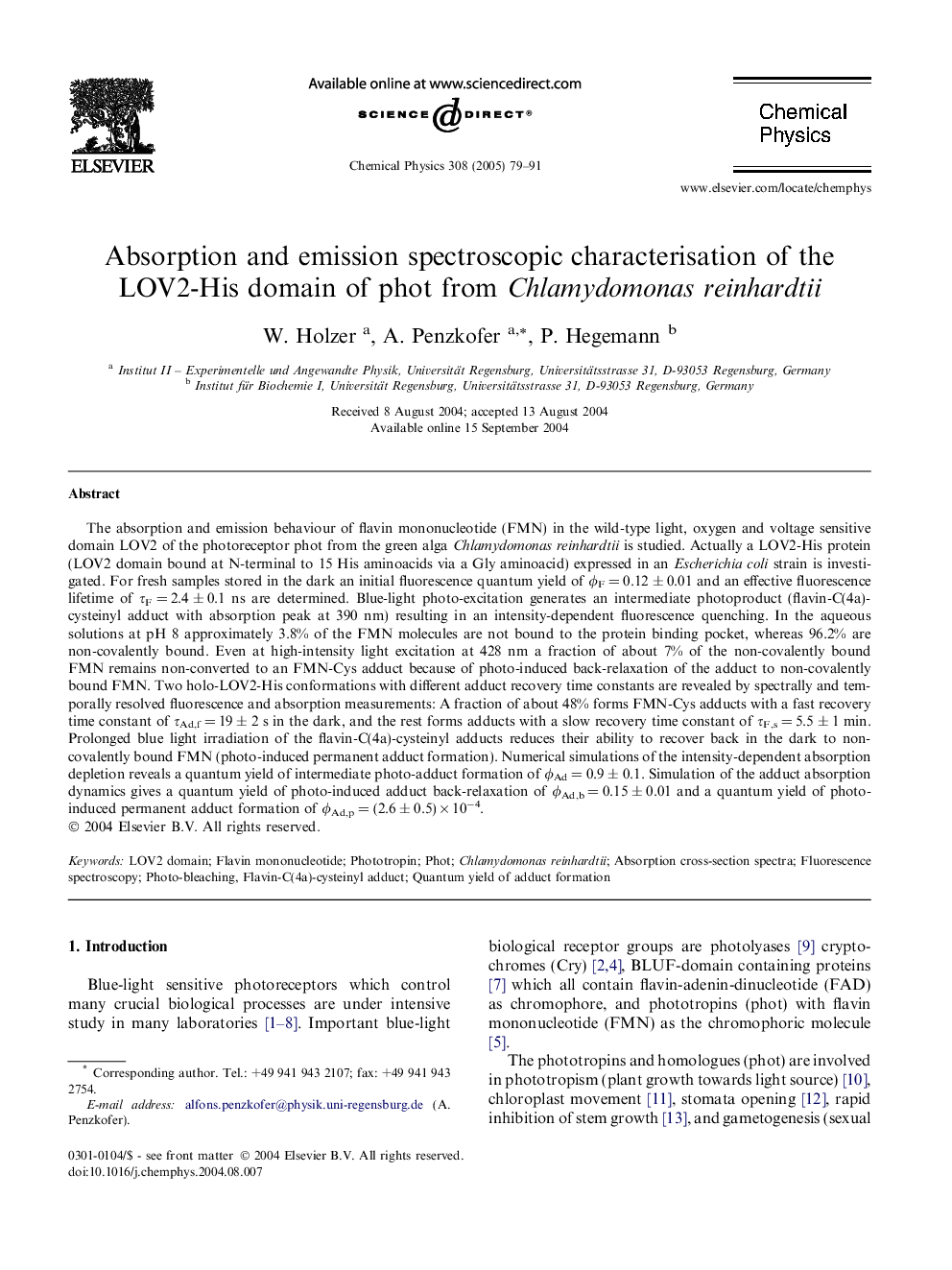| کد مقاله | کد نشریه | سال انتشار | مقاله انگلیسی | نسخه تمام متن |
|---|---|---|---|---|
| 9575697 | 1504351 | 2005 | 13 صفحه PDF | دانلود رایگان |
عنوان انگلیسی مقاله ISI
Absorption and emission spectroscopic characterisation of the LOV2-His domain of phot from Chlamydomonas reinhardtii
دانلود مقاله + سفارش ترجمه
دانلود مقاله ISI انگلیسی
رایگان برای ایرانیان
کلمات کلیدی
موضوعات مرتبط
مهندسی و علوم پایه
شیمی
شیمی تئوریک و عملی
پیش نمایش صفحه اول مقاله

چکیده انگلیسی
The absorption and emission behaviour of flavin mononucleotide (FMN) in the wild-type light, oxygen and voltage sensitive domain LOV2 of the photoreceptor phot from the green alga Chlamydomonas reinhardtii is studied. Actually a LOV2-His protein (LOV2 domain bound at N-terminal to 15 His aminoacids via a Gly aminoacid) expressed in an Escherichia coli strain is investigated. For fresh samples stored in the dark an initial fluorescence quantum yield of ÏF = 0.12 ± 0.01 and an effective fluorescence lifetime of ÏF = 2.4 ± 0.1 ns are determined. Blue-light photo-excitation generates an intermediate photoproduct (flavin-C(4a)-cysteinyl adduct with absorption peak at 390 nm) resulting in an intensity-dependent fluorescence quenching. In the aqueous solutions at pH 8 approximately 3.8% of the FMN molecules are not bound to the protein binding pocket, whereas 96.2% are non-covalently bound. Even at high-intensity light excitation at 428 nm a fraction of about 7% of the non-covalently bound FMN remains non-converted to an FMN-Cys adduct because of photo-induced back-relaxation of the adduct to non-covalently bound FMN. Two holo-LOV2-His conformations with different adduct recovery time constants are revealed by spectrally and temporally resolved fluorescence and absorption measurements: A fraction of about 48% forms FMN-Cys adducts with a fast recovery time constant of ÏAd,f = 19 ± 2 s in the dark, and the rest forms adducts with a slow recovery time constant of ÏF,s = 5.5 ± 1 min. Prolonged blue light irradiation of the flavin-C(4a)-cysteinyl adducts reduces their ability to recover back in the dark to non-covalently bound FMN (photo-induced permanent adduct formation). Numerical simulations of the intensity-dependent absorption depletion reveals a quantum yield of intermediate photo-adduct formation of ÏAd = 0.9 ± 0.1. Simulation of the adduct absorption dynamics gives a quantum yield of photo-induced adduct back-relaxation of ÏAd,b = 0.15 ± 0.01 and a quantum yield of photo-induced permanent adduct formation of ÏAd,p = (2.6 ± 0.5) Ã 10â4.
ناشر
Database: Elsevier - ScienceDirect (ساینس دایرکت)
Journal: Chemical Physics - Volume 308, Issues 1â2, 10 January 2005, Pages 79-91
Journal: Chemical Physics - Volume 308, Issues 1â2, 10 January 2005, Pages 79-91
نویسندگان
W. Holzer, A. Penzkofer, P. Hegemann,